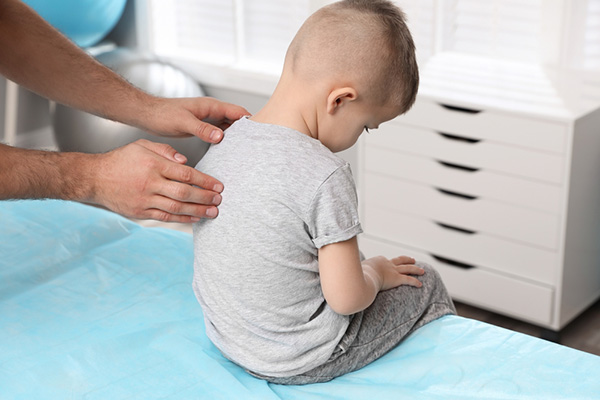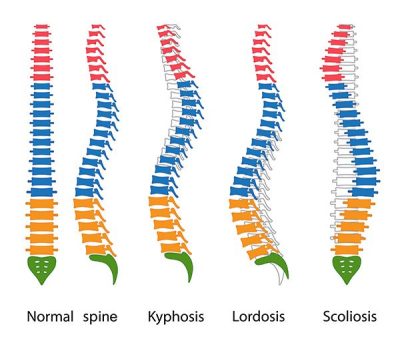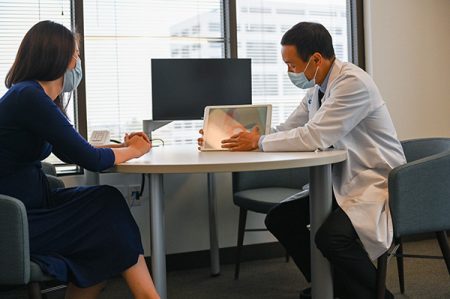Congenital Spinal Deformities

What Are Congenital Spine Deformities?
Congenital spine deformities are disorders of the spine that develop in utero. During fetal development, vertebrae do not form correctly, causing abnormal spinal alignment that can affect a baby’s nerves. A baby can develop one or more types of congenital spine deformities.
Some congenital spine deformities are related to spina bifida. Babies with spina bifida may have a defect on their back where the skin over the spinal cord does not grow correctly.
Types of Congenital Spine Deformities

Kyphosis: Affects the upper back area and causes the spine to bend forward resulting in a humpback appearance. If the spine curvature measures 50 degrees or greater, it is defined as kyphosis.
Lordosis: Impacts the lower back, causing the spine to have an inward curvature.
Scoliosis: A sideways curvature or twisting of the spine. Congenital scoliosis is the most common type of congenital spine deformity.
Tethered spinal cord: When a spinal cord is fixed to the spinal canal, rather than floating. This causes the cord to stretch like a rubber band and can result in damage to the nerves.
What Causes Congenital Spine Deformities?
While the exact cause of congenital spine deformities is not determined, they have been linked to some genetic and environmental factors. Environmental factors that have been linked to congenital spine defects include exposure to toxins, use of antiepileptic medication and maternal diabetes.
Symptoms of congenital spine deformities
Symptoms of a child’s spine deformity will vary depending on their type of condition, the severity and the affected region. Some congenital abnormalities may be benign and cause no spinal deformity and can go undetected. Some of the physical signs include:
- Tilted pelvis
- Difficulty walking, breathing
- Abnormal curve in spine
- Uneven shoulders, hips, waist, legs
- Bowel issues
Diagnosis of congenital spine deformities
Detection of congenital spine deformities can occur immediately after birth during a physical exam. However, some spinal deformities don’t start showing signs until later in childhood. The following tests can be used to help diagnose a spinal deformity:
Physical Exam: Checking the back and spine for signs of misalignment.
X-rays: Imaging to show abnormal spinal bones and angles.
Magnetic Resonance Imaging (MRI): Utilizing magnets and radio waves to see detailed images of the spinal cord structures and tissues.
CT Scan: Using x-ray equipment to create highly detailed images of the spinal column and cord
EOS X-ray: An imaging technology that uses low doses of radiation to see how the spine aligns when the child is in an upright position.
Early detection of congenital spine deformities
Congenital spine deformities can sometimes be detected in utero. They are often found during the anatomical ultrasound between 18-24 weeks pregnant; however, some abnormalities can be caught earlier. Once detected by your OB/GYN, CHOC can confirm the diagnosis and provide more comprehensive condition education, as well as start developing a treatment plan with our team of pediatric specialists at The Fetal Care Center of Southern California.
Treatment of Congenital Spine Deformities
The goal of treatment for congenital spine deformities is to prevent further progression of the deformity and restore any lost function. Nonoperative treatments are usually recommended before surgical procedures are discussed. Surgery may be recommended for your child’s spine deformity if:
- They experience severe pain not relieved by nonoperative treatments.
- The spinal deformity is progressing.
- The deformity has caused compression of the spinal cord.
- The curve is measuring higher than the normal benchmark.
- The condition has caused unbearable physical deformity.
Nonoperative Treatments
Pain Medication: Medication can be given to help alleviate severe pain.
Bracing: As the child grows, bracing can keep the spine in alignment. This will help reduce the pressure on back and straighten the spine. The type of brace and the amount of time spent in the brace will be determined by your child’s doctor.
Mehta Casting: A series of plaster and fiberglass casts used in cases of early onset scoliosis that gently correct spine curvature over time.
Physical Therapy: Physical therapy focuses on stretches and exercises to prevent the spine from curving more and assist with restoring some normal function.
Surgical Treatments
Growing Rods: Temporary implants that control the spinal curvature while the child grows. A fusion is performed at the top and bottom of the spine with hooks to hold the rod in place. Every 6 to 12 months after the initial surgery, a minor surgery is conducted to lengthen the rod through a small incision in the back to allow the spine to continue growing and correcting the curve.
Magnetic Expansion Control System (MAGEC): An adjustable growing rod system similar to growing rods that utilizes magnetic technology to lengthen the rods without repeat surgeries. After the initial surgery, the implants will be controlled by a remote.
Spinal Fusion: After your child has stopped growing, or if growing rods are not a viable option, fusion surgery may be recommended. This involves permanently connecting vertebrae together to stabilize the curved part of the spine. The spine is straightened and fused together with metal implants.
Expansion Thoracostomy/VEPTR: Some deformities can affect your child’s rib and lung development. Expansion Thoracostomy uses an expandable metal rod that acts as a rib for underdeveloped chests. By expanding the chest wall, this creates room for the lungs to develop and the spine to grow straight. The VEPTR will need to be surgically adjusted as your child grows.
Long-term outlook of congenital spine deformities
Long-term considerations are dependent on the severity of a child’s condition. Early detection and treatment of congenital spine deformities can help prevent severe issues for some children. Leaving spinal deformities untreated can cause problems with a child’s heart, kidneys, urinary tract, breathing and walking. Severe deformities, like curves exceeding 90 degrees, can cause a serious threat to long-term health of pulmonary function.
The Fetal Care Center of Southern California

If an abnormality is detected before your baby is born, our team of pediatric experts at the Fetal Care Center of Southern California can confirm your baby’s diagnosis, provide extensive condition education and counseling, and begin comprehensive treatment planning for after your baby’s birth.













